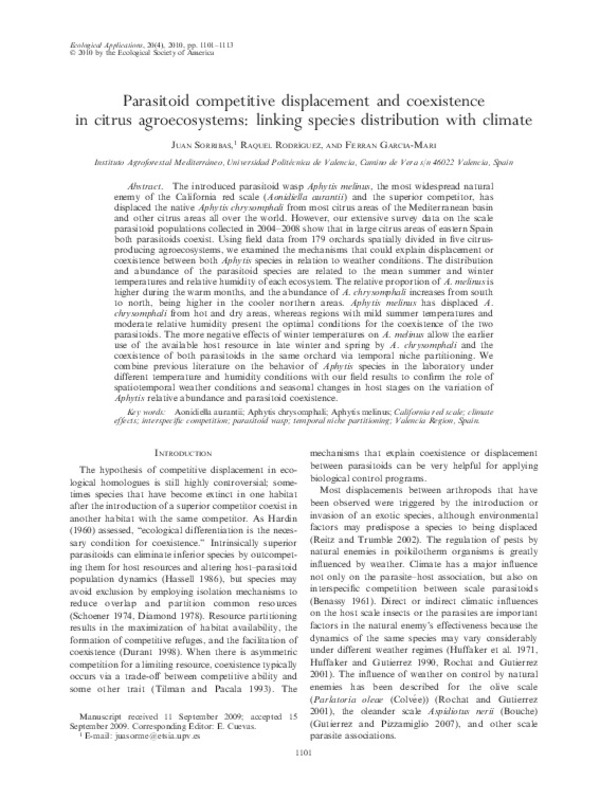JavaScript is disabled for your browser. Some features of this site may not work without it.
Buscar en RiuNet
Listar
Mi cuenta
Estadísticas
Ayuda RiuNet
Admin. UPV
Parasitoid competitive displacement and coexistence in citrus agroecosystems: linking species distribution with climate
Mostrar el registro sencillo del ítem
Ficheros en el ítem
| dc.contributor.author | Sorribas Mellado, Juan José
|
es_ES |
| dc.contributor.author | Rodríguez, Raquel
|
es_ES |
| dc.contributor.author | García Mari, Ferran
|
es_ES |
| dc.date.accessioned | 2016-12-12T11:17:06Z | |
| dc.date.available | 2016-12-12T11:17:06Z | |
| dc.date.issued | 2010-06 | |
| dc.identifier.issn | 1051-0761 | |
| dc.identifier.uri | http://hdl.handle.net/10251/75108 | |
| dc.description.abstract | [EN] The introduced parasitoid wasp Aphytis melinus, the most widespread natural enemy of the California red scale (Aonidiella aurantii) and the superior competitor, has displaced the native Aphytis chrysomphali from most citrus areas of the Mediterranean basin and other citrus areas all over the world. However, our extensive survey data on the scale parasitoid populations collected in 2004–2008 show that in large citrus areas of eastern Spain both parasitoids coexist. Using field data from 179 orchards spatially divided in five citrusproducing agroecosystems, we examined the mechanisms that could explain displacement or coexistence between both Aphytis species in relation to weather conditions. The distribution and abundance of the parasitoid species are related to the mean summer and winter temperatures and relative humidity of each ecosystem. The relative proportion of A. melinus is higher during the warm months, and the abundance of A. chrysomphali increases from south to north, being higher in the cooler northern areas. Aphytis melinus has displaced A. chrysomphali from hot and dry areas, whereas regions with mild summer temperatures and moderate relative humidity present the optimal conditions for the coexistence of the two parasitoids. The more negative effects of winter temperatures on A. melinus allow the earlier use of the available host resource in late winter and spring by A. chrysomphali and the coexistence of both parasitoids in the same orchard via temporal niche partitioning. We combine previous literature on the behavior of Aphytis species in the laboratory under different temperature and humidity conditions with our field results to confirm the role of spatiotemporal weather conditions and seasonal changes in host stages on the variation of Aphytis relative abundance and parasitoid coexistence. | es_ES |
| dc.description.sponsorship | We thank Eugenia Rodrigo of the Ecosistemas Agroforestales Department of the Valencia Polytechnic University (Spain) for her help with Aphytis identification, Robert Luck from the University of California ( USA) for information on the sex ratio, and Alejandro Tena and Rosa Vercher from the Instituto Agroforestal Mediterraneo (Valencia, Spain), Maria Jesus Verdu (Instituto Valenciano de Investigaciones Agrarias, Spain), Jacques Van Alphen and Joan van Baaren from the ECOBIO Institute (Rennes, France) for their recommendations and critical review. Special thanks to all the Citrus Phytosanitary Survey staff for the field trap samples and the two anonymous reviewers who provided helpful comments on the manuscript. English corrections were carried out by Centro de Lenguas of the Valencia Polytechnic University. This work was supported by the AGL2005-07155-C03-03 project of the Spanish Ministry of Education and Science. | |
| dc.language | Inglés | es_ES |
| dc.publisher | Ecological Society of America | es_ES |
| dc.relation.ispartof | Ecological Applications | es_ES |
| dc.rights | Reserva de todos los derechos | es_ES |
| dc.subject | Aonidiella aurantii | es_ES |
| dc.subject | Aphytis chrysomphali | es_ES |
| dc.subject | Aphytis melinus | es_ES |
| dc.subject | California red scale | es_ES |
| dc.subject | Climate effects | es_ES |
| dc.subject | Interspecific competition | es_ES |
| dc.subject | Parasitoid wasp | es_ES |
| dc.subject | Temporal niche partitioning | es_ES |
| dc.subject | Valencia Region, Spain | es_ES |
| dc.subject.classification | PRODUCCION VEGETAL | es_ES |
| dc.title | Parasitoid competitive displacement and coexistence in citrus agroecosystems: linking species distribution with climate | es_ES |
| dc.type | Artículo | es_ES |
| dc.identifier.doi | 10.1890/09-1662.1 | |
| dc.relation.projectID | info:eu-repo/grantAgreement/MEC//AGL2005-07155-C03-03/ES/CONTROL BIOLÓGICO Y UMBRALES DE TRATAMIENTO DEL PIOJO ROJO DE CALIFORNIA AONIDIELLA AURANTII (HOMOPTERA:DIASPIDIDAE) EN CITRICOS/ | es_ES |
| dc.rights.accessRights | Abierto | es_ES |
| dc.contributor.affiliation | Universitat Politècnica de València. Instituto Agroforestal Mediterráneo - Institut Agroforestal Mediterrani | es_ES |
| dc.contributor.affiliation | Universitat Politècnica de València. Escuela Técnica Superior de Ingeniería Agronómica y del Medio Natural - Escola Tècnica Superior d'Enginyeria Agronòmica i del Medi Natural | es_ES |
| dc.description.bibliographicCitation | Sorribas Mellado, JJ.; Rodríguez, R.; García Mari, F. (2010). Parasitoid competitive displacement and coexistence in citrus agroecosystems: linking species distribution with climate. Ecological Applications. 4(20):1101-1104. https://doi.org/10.1890/09-1662.1 | es_ES |
| dc.description.accrualMethod | S | es_ES |
| dc.relation.publisherversion | https://dx.doi.org/10.1890/09-1662.1 | es_ES |
| dc.description.upvformatpinicio | 1101 | es_ES |
| dc.description.upvformatpfin | 1104 | es_ES |
| dc.type.version | info:eu-repo/semantics/publishedVersion | es_ES |
| dc.description.volume | 4 | es_ES |
| dc.description.issue | 20 | es_ES |
| dc.relation.senia | 39519 | es_ES |
| dc.identifier.pmid | 20597293 | |
| dc.contributor.funder | Ministerio de Educación y Ciencia |








